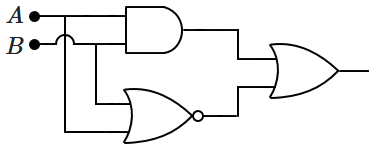The truth table for a circuit is given by:
\(A\)
\(B\)
\(C\)
\(Y\) (Output)
\(1\)
\(X\)
\(1\)
\(1\)
\(0\)
\(1\)
\(X\)
\(1\)
All other cases
\(0\)
Here, \(X\) represents either \(0\) or \(1\). \(A,B,\) and \(C\) are the inputs. Which of the following is the correct circuit?
1.

2.

3.

4.






To unlock all the explanations of this course, you need to be enrolled.

To unlock all the explanations of this course, you need to be enrolled.
Here, \(T=\) absolute temperature, \(V=\) voltage across the diode, \(k=\) Boltzmann's constant and \(i_0=\) the drift current.
Then, the differential resistance of the diode \(\left(\dfrac{dV}{di}\right)\) is given by:
1. \(\text{(constant)}i\)
2. \(\text{(constant)}i^2\)
3. \(\dfrac{\text{constant}}{i}\)
4. \(\text{(constant)}e^{-\beta i},~\beta\text{-constant}\)

To unlock all the explanations of this course, you need to be enrolled.

To unlock all the explanations of this course, you need to be enrolled.
| 1. |  |
| 2. |  |
| 3. |  |
| 4. |  |

To unlock all the explanations of this course, you need to be enrolled.

To unlock all the explanations of this course, you need to be enrolled.

This diode is connected with a resistance of \(5~\Omega\) in series with it as shown below:

Which of the following shows the dependence of the voltage \(V_{AB}\) and the current \(i,\) when the diode is forward-biased?
(\(V_{AB}\) in volt, \(i\) in ampere)
| 1. | \(V_{A B}=i\cdot5+0.6\) |
| 2. | \(V_{A B}=i\cdot5-0.6\) |
| 3. | \(V_{A B}=i\cdot5+(0.6-5)\) |
| 4. | \(V_{A B}=i\cdot5+\left(0.6+5\right)\) |

To unlock all the explanations of this course, you need to be enrolled.

To unlock all the explanations of this course, you need to be enrolled.
(consider the diodes as ideal.)

| 1. |  |
2. |  |
| 3. |  |
4. |  |

To unlock all the explanations of this course, you need to be enrolled.

To unlock all the explanations of this course, you need to be enrolled.

| 1. | \(V_o=V_i+E\) |
| 2. | \(V_o=V_i-E\) |
| 3. | \(V_o=V_i,\) only when \(V_i>E\) |
| 4. | \(V_o=V_i,\) only when \(V_i<E\) |

To unlock all the explanations of this course, you need to be enrolled.

To unlock all the explanations of this course, you need to be enrolled.

1. \(V_A>V_B+V_0\)
2. \(V_A<V_B+V_0\)
3. \(V_A>V_B-V_0\)
4. \(V_A<V_B-V_0\)

To unlock all the explanations of this course, you need to be enrolled.

To unlock all the explanations of this course, you need to be enrolled.

| 1. | no current flows in the circuit |
| 2. | current flows anticlockwise |
| 3. | current flows clockwise |
| 4. | current only flows through \(D_2\) and not through \(D_1\) |

To unlock all the explanations of this course, you need to be enrolled.

To unlock all the explanations of this course, you need to be enrolled.

1. \(\text{If}~V_{AB}>0, V_{AX}>0\)
2. \(\text{If}~V_{AB}>0, V_{XY}>0\)
3. \(\text{If}~V_{AB}<0, V_{XY}>0\)
4. \(\text{If}~V_{AB}<0, V_{AX}>0\)

To unlock all the explanations of this course, you need to be enrolled.

To unlock all the explanations of this course, you need to be enrolled.

The current through the circuit is:
1. \(40\) mA
2. \(54\) mA
3. \(33\) mA
4. \(26\) mA

To unlock all the explanations of this course, you need to be enrolled.

To unlock all the explanations of this course, you need to be enrolled.






